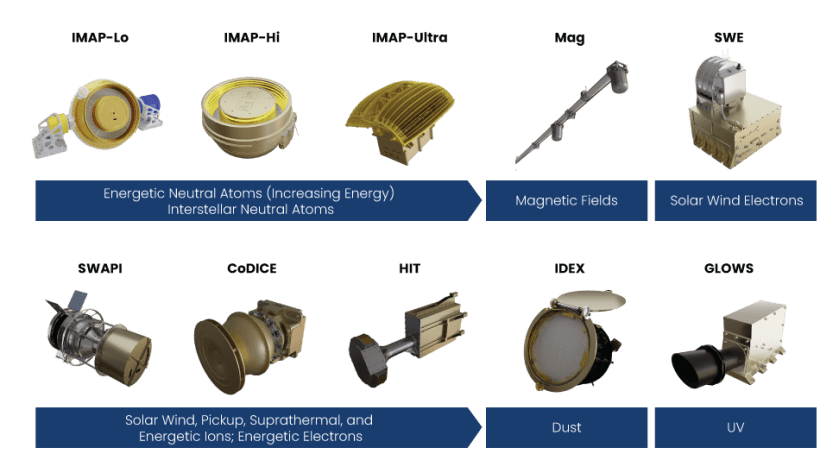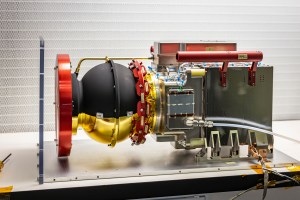With the installation of a charged particle detector on Dec. 3, 2024, all 10 of NASA’s Interstellar Mapping and Acceleration Probe (IMAP) science instruments have been fully integrated on the spacecraft.
Slated to launch no earlier than September 2025, IMAP will map the boundaries of the heliosphere — the protective bubble surrounding the Sun and planets that is inflated by the constant stream of particles from the Sun called the solar wind. As a modern-day celestial cartographer, IMAP will also explore and chart the vast range of particles in interplanetary space, helping to investigate two of the most important overarching issues in heliophysics: the energization of charged particles from the Sun and the interaction of the solar wind with interstellar space. IMAP plans to provide near real-time information about the solar wind to provide advanced space weather warnings from its location at Lagrange point 1, one million miles from Earth toward the Sun.

Credits: NASA/Johns Hopkins APL/Princeton/Ed Whitman
To achieve these goals, IMAP will use 10 science instruments built by multiple organizations and integrated at the Johns Hopkins Applied Physics Laboratory (APL) in Laurel, Maryland. The instruments, listed in order by when they were integrated, are:
-
- Interstellar Dust Experiment (IDEX): a mass spectrometer studying interstellar dust and interplanetary dust particles, designed and built by the Laboratory for Atmospheric and Space Physics in Boulder, Colorado.
- IMAP Magnetometer (MAG): a pair of identical magnetometers that measure the magnetic field near the spacecraft, designed and built by Imperial College London.
- IMAP-Ultra: two high-energy-range energetic neutral atom (ENA) imagers designed and built at APL.
- High-energy Ion Telescope (HIT): a high-energy ion imager designed and built by NASA’s Goddard Space Flight Center.
- Solar Wind Electron (SWE) instrument: maps electrons from the solar wind in three dimensions, designed and built by the Los Alamos National Laboratory (LANL) in collaboration with the Southwest Research Institute (SwRI).
- GLObal Solar Wind Structure (GLOWS) instrument: a Lyman-alpha photometer that measures the ultraviolet glow from interstellar hydrogen and helium to investigate the solar wind and studies its evolution over time, designed and built by the Space Research Center of the Polish Academy of Sciences in Warsaw, Poland.
- Solar Wind and Pickup Ion (SWAPI) instrument: measures ions from the solar wind and particles from beyond the solar system, designed and built by Princeton University.
- IMAP-Hi: two medium-energy-range ENA imagers to help advance our understanding of the evolution of the outer heliosphere, designed and built by LANL in collaboration with SwRI, the University of New Hampshire (UNH), and the University of Bern in Switzerland.
- IMAP-Lo: a low-energy-range ENA imager mounted on a pivot platform to help advance our understanding of the evolution of the outer heliosphere, designed and built by UNH in collaboration with SwRI, APL, and the University of Bern.
- Compact Dual Ion Composition Experiment (CoDICE): measures the distributions and composition of interstellar pickup ions (charged particles that make it through the boundary of the heliosphere), designed and built by SwRI.

CoDICE was the final instrument integrated on IMAP.
Credits: NASA/Princeton/Johns Hopkins APL
The integrated spacecraft is now running through a series of operations simulating the launch and postlaunch environments to ensure the spacecraft can withstand the rigors of space. While at APL, IMAP will also undergo a vibration and separation shock test, which replicates the launch vehicle separating from the spacecraft after takeoff.
Princeton University professor and principal investigator David J. McComas leads the mission with an international team of more than 25 partner institutions. APL is managing the development phase and building the spacecraft, and it will operate the mission. IMAP is the fifth mission in NASA’s Solar Terrestrial Probes (STP) Program portfolio. The Explorers and Heliophysics Projects Division at Goddard Space Flight Center manages the STP Program for the agency’s Heliophysics Division of NASA’s Science Mission Directorate.
By Mara Johnson-Groh
NASA’s Goddard Space Flight Center, Greenbelt, Md.
